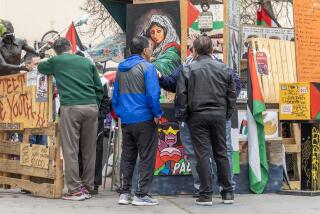Anniversary of Treaty Celebrated
- Share via
NORTH HOLLYWOOD — The firing of cannons added a new note of authenticity to the annual reenactment Sunday of the 1847 signing of the Campo de Cahuenga Treaty.
And the car alarms they set off in the neighborhood injected a bit of the modern day into the costumed proceedings. But participants in the historic reenactment on the site of the treaty signing across from Universal Studios weren’t absolute sticklers for authenticity.
Charlie Cooke of Atwater, a Chumash Indian, began the proceedings with a purification ceremony that called for burning sage leaves. “We’re not going to take the time to rub sticks together,” Cooke told the crowd of about 100 gathered for the event. “We’ll use a lighter.”
The table used during the ceremony was, some local historians believe, the same one where American Lt. Col. John C. Fremont and Mexican Gen. Andres Pico sat down to sign the treaty 153 years ago. Next to the table was an electric piano.
And the man in buckskin portraying Kit Carson, who was Fremont’s scout, hardly resembled the original. “Our Kit Carson is about 6 feet, 4 inches,” said Guy Weddington McCreary, president of the Campo de Cahuenga Historical Memorial Assn., with a laugh. “The real guy was about 5 feet 6.”
The meaning of the event is what’s truly important, said McCreary, especially because the site is now somewhat endangered.
The treaty signing came in the wake of Fremont’s victory over Mexican troops in the Mexican-American War of 1846-48. It secured California for the U.S. and eventually led to statehood.
“It allowed us to become a whole nation, from the Atlantic to the Pacific,” McCreary said. It also provided a lesson about mercy.
“When the Mexicans were defeated in California,” he said, “some in the military wanted to take revenge, to shoot Pico and others on the spot. But the treaty agreed to by Fremont allowed the Mexicans who wanted to return home to do so safely.”
The subway now under construction from Hollywood into the San Fernando Valley will run near the site, which is a small park dominated by an adobe constructed to look like the one that was there in 1847. A short distance away, the subway’s Universal City station is being built.
But the historical association doesn’t feel any threat from the Metropolitan Transportation Authority, which oversees the subway.
“They’re our allies,” McCreary said. “They sent archeologists in to check the area.” The archeologists found stone walls and artifacts that established the location of the original adobe just west of where the re-creation of it sits.
The real problem, McCreary said, lies with the city, which is planning to widen Lankershim Boulevard, in part to deal with the increased traffic that the subway station is expected to generate. His group is trying to get the entire site of the original adobe registered as a national landmark, and thus dash the city’s plans.
“We have to convince people how important this place is to our history,” McCreary said.
The cannons at the event were brought in by the Richmond Howitzers Artillery, a Thousand Oaks-based group that participates in historical event re-creations. “Mostly we do Civil War reenactments,” said John Billinger, a member of the volunteer group. “We just started branching out to include Mexican-American events too.”
Which explains the variety of garb worn by the troop. Although Billinger was wearing a copy of a private’s uniform from the 1840s, most of the “soldiers” had donned bits and pieces of their Civil War clothing. “We’ll get more authentic as we do more of these Mexican-American events,” Billinger said. “In the meantime, you gotta make do with what you got.”
More to Read
Sign up for Essential California
The most important California stories and recommendations in your inbox every morning.
You may occasionally receive promotional content from the Los Angeles Times.














